Do Solar Path Lights or Solar Garden Lights Offer Better Illumination for Landscaping?
I’ve spent enough evenings tripping over garden hoses in the dark to know that good outdoor lighting isn’t just nice—it’s essential. Homeowners like us often stand in the store aisle, staring at rows of solar options, wondering which will actually light up the backyard without looking like a half-hearted string of Christmas bulbs. Enter the big question: Do solar path lights or solar garden lights deliver better illumination for landscaping? It’s not a one-size-fits-all answer. Path lights are all about guiding your steps safely along walkways, while garden lights lean into creating that magical, ambient vibe around flower beds and patios. Both run on free solar energy, but their strengths shine in different spots. In this piece, we’ll break it down step by step, drawing from real-world tests and specs to help you pick what fits your yard’s needs. Whether you’re aiming for safety on a winding driveway or a cozy glow for summer barbecues, understanding these differences can transform your outdoor space from shadowy chaos to inviting retreat.
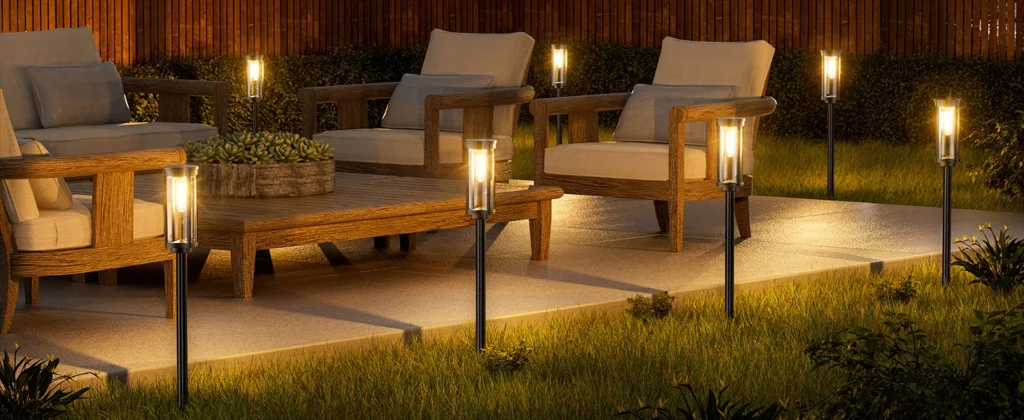
Purpose Difference: Decoration vs. Navigation
At their core, solar path lights and solar garden lights serve distinct roles in your landscaping setup, and getting this right sets the tone for everything else. Solar path lights prioritize functionality—they’re designed to mark routes, like a subtle breadcrumb trail from the garage to the back door. Think of them as the unsung heroes that prevent stubbed toes during late-night dog walks. On the flip side, solar garden lights are more about flair, sprinkling decorative sparkle over shrubs, borders, or seating areas to highlight your plants’ nighttime beauty.
To illustrate the split:
- Solar Path Lights: Focus on visibility for high-traffic areas. They’re often taller (around 15-20 inches) and spaced 6-8 feet apart to create a continuous line of light, ensuring you can see obstacles like roots or uneven pavers.
- Solar Garden Lights: Emphasize aesthetics over utility. Shorter and more scattered (think clusters around a birdbath), they cast softer patterns to accentuate foliage textures without overpowering the scene.
- Hybrid Overlap: Some models blur the lines, like stake lights that double as both, but sticking to purpose keeps your energy—and budget—in check.
I remember installing a set of basic path lights along my gravel walkway last summer; they didn’t wow visually, but navigating after sunset felt effortless. Garden lights, though? They turned a plain herb patch into an evening focal point, drawing compliments from neighbors. The key takeaway: Match the light to the task to avoid wasting that precious solar charge on mismatched spots.
Light Output & Beam Pattern: Lumens, Tones, and Spread
Nothing kills the mood faster than lights that flicker out too soon or wash everything in a harsh glare. When comparing illumination, solar path lights generally edge out garden lights in raw output, thanks to their practical bent. Lumens measure brightness—aim for 100-200 per fixture for paths to ensure safe footing, while garden setups thrive on 20-50 lumens for that subtle charm. Path lights often hit 50-150 lumens, casting a focused beam (around 120 degrees) straight down or forward to spotlight the ground ahead. Garden lights, by contrast, use wider angles (up to 360 degrees) for diffused glows, creating starry patterns but covering less linear distance.
Color tone plays a huge role too. Warm white (2700-3000K) feels inviting and mimics candlelight, ideal for garden ambiance, while cooler tones (4000-6500K) provide crisper visibility for paths—though they can feel stark in cozy spots. Beam patterns vary: Path lights favor narrow, directional spreads to avoid light pollution into neighbors’ yards, whereas garden lights employ lenses for twinkling effects, like fireflies dancing over hostas.
Here’s a quick comparison table based on popular models:
| Feature | Solar Path Lights | Solar Garden Lights |
|---|---|---|
| Typical Lumens | 50-150 (e.g., Osord at 150) | 10-50 (e.g., decorative stakes at 14) |
| Beam Angle | 90-120 degrees, focused downward | 180-360 degrees, omnidirectional |
| Color Options | Cool white for clarity; some amber | Warm white dominant; RGB accents |
In practice, if your landscaping involves a meandering stone path through the yard, path lights’ higher lumens will keep things lit without blind spots. For a whimsical border around raised beds, garden lights’ softer beams add personality without the intensity.
Design & Aesthetic Appeal: Artistry Meets Safety
Landscaping isn’t just about function—it’s about crafting a space that feels like an extension of your home’s personality. Solar garden lights win hands-down for artistic flair, with shapes like lanterns, orbs, or even mushroom caps that double as sculptures by day. They blend seamlessly into flower arrangements, casting intricate shadows that make petals pop under moonlight. Path lights, meanwhile, lean toward clean, symmetrical lines—think sleek metal stakes or low-profile bollards that line up like soldiers along borders, prioritizing safety over showiness.
Aesthetic choices impact safety too. Garden lights’ playful designs can sometimes obscure views if over-clustered, but their low height (under 12 inches) keeps them unobtrusive. Path lights’ taller profiles ensure even illumination, reducing trip hazards while maintaining a polished look that complements modern hardscapes like flagstone or brick.
Pros and cons in a nutshell:
- Garden Lights Pros: Versatile styling (glass, plastic, or metal finishes); enhances curb appeal with thematic sets (e.g., vintage lanterns for cottage gardens).
- Garden Lights Cons: May lack the height for overhead branches, potentially dimming output in shaded landscaping.
- Path Lights Pros: Symmetrical placement promotes balance; durable builds withstand foot traffic in high-use areas.
- Path Lights Cons: Can look utilitarian if not mixed with greenery—pair them with vines for softer edges.
One tip from my own yard tweak: Layer both types. Flank a central path with utilitarian path lights, then dot garden accents along the edges for that “wow” factor without sacrificing security.
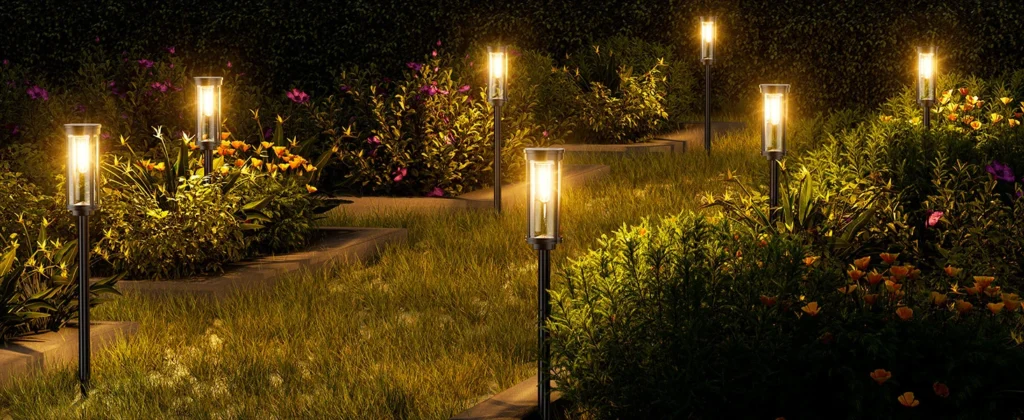
Energy Efficiency: Maximizing Coverage on Stored Power
Solar tech has come a long way, but efficiency boils down to how well lights stretch their daytime charge across the night. Both types sip power thanks to LEDs (up to 90% more efficient than old incandescents), but path lights often consume less per square foot of coverage due to their targeted beams. A single path light might use 1-2 watts to light 10-15 feet of walkway, while garden lights spread wider but dimmer, needing more units for even coverage—potentially upping total draw.
Battery tech is key: Look for lithium-ion over nickel-cadmium for better cold-weather holdover and 10,000+ hour lifespans. Monocrystalline panels (20-22% conversion rate) charge faster than polycrystalline, giving both types an edge on cloudy days. Runtime? Expect 8-12 hours from a full sun soak, but path lights’ focused output means they cover linear spaces (like 50 feet of trail) with fewer batteries overall.
Efficiency checklist for your landscaping:
- Panel Size: Larger (5-7 inches) for path lights in open areas; compact for tucked-away garden spots.
- Modes: Dimmable or sensor-triggered saves 20-30% energy—great for both.
- Coverage Math: Path: 1 light per 6-8 feet. Garden: 1 per 3-5 feet for balanced glow.
In my experience, mixing efficient models cut my “dead light” replacements by half. Path lights shine here for structured yards, but garden variants with MPPT charging tech close the gap for creative, scattered installs.
Weather Resistance: Standing Up to the Elements
Outdoor lights face Mother Nature’s full wrath—rain, frost, hail—and that’s where ratings like IP65 become your best friend. Standard outdoor solar lights hit IP44 (splash-proof), fine for mild climates, but for serious landscaping exposure, aim higher. Bitpott’s IP65+ coating takes it up a notch: This ABS plastic shell with enhanced sealing repels heavy rain, snow, and even sleet, while the “+” adds UV protection against fading in sunny exposures. Path lights, staked firmly in high-wind paths, benefit most from this ruggedness, enduring foot traffic and storms without budging.
Garden lights, nestled in soil beds, deal more with moisture buildup, so their corrosion-resistant finishes (like stainless steel) prevent rust on ornate details. Both types now boast 25,000-hour LEDs, but Bitpott’s all-weather design ensures consistent performance year-round, even in freeze-thaw cycles.
Durability ranked:
- IP65+ (Bitpott Standard): Handles submersion up to 1 meter; ideal for sloped landscaping.
- IP65 Basics: Dust-tight and jet-spray proof; solid for paths but test in hail-prone areas.
- Lower Ratings (IP44): Budget garden picks—okay for covered patios, risky in open fields.
Pro move: Elevate stakes slightly in soggy yards to dodge puddles. With Bitpott’s edge, your investment weathers literal storms, keeping illumination steady through seasons.
Ease of Setup: Stakes In, Lights On
Who has time for electrician drama? Solar’s big sell is simplicity—no wires, no digging trenches. Solar path lights win for speed: Just twist stakes into soft ground along your walkway, and they’re live in under 10 minutes per unit. Flexible options include screw mounts for hard surfaces like concrete driveways, making them adaptable to varied landscaping.
Garden lights offer more placement freedom—short stakes for borders or clips for hanging in arbors—but they might need fiddling with angles for optimal panel sun exposure. Both auto-activate at dusk, but path lights’ linear install feels more foolproof for beginners.
Step-by-step setup sequence:
- Site Scout: Pick full-sun spots (6+ hours daily) away from shade trees.
- Assemble: Snap pole to base; attach light head (2-3 minutes).
- Plant: Push into soil or secure with screws—test stability with a gentle tug.
- Charge & Test: Full day in sun, then check glow at night.
I set up a dozen path lights one lazy afternoon; by dinner, the yard was transformed. Garden ones took longer for artistic spacing, but the payoff in vibe was worth it. Bottom line: Both are DIY-friendly, but paths suit quick, no-fuss jobs.
Blend for the Perfect Landscape Balance
After weighing the scales—from purpose-driven navigation to decorative whimsy, punchy lumens to efficient sips of power—it’s clear neither solar path lights nor solar garden lights reign supreme outright. Path lights excel at structured illumination, delivering safe, reliable visibility for walkways and driveways where every step counts. Garden lights, with their artistic beams and ambient charm, elevate the visual appeal of beds, patios, and focal features, turning ordinary landscaping into a nighttime storybook.
The real magic? Don’t choose—combine them. Line your main thoroughfares with path lights for safety, then weave in garden accents for soul. Brands like Bitpott, with their IP65+ toughness and bright outputs, bridge both worlds affordably. Ultimately, your yard’s layout dictates the mix: Prioritize paths for family-heavy zones, gardens for entertaining nooks. Dive in, experiment under the stars, and watch how a little solar savvy makes your outdoor escape glow just right.

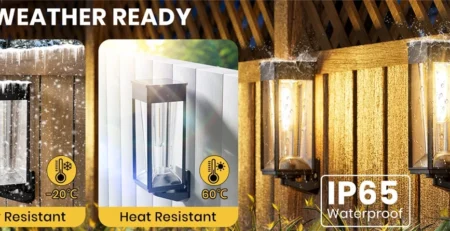
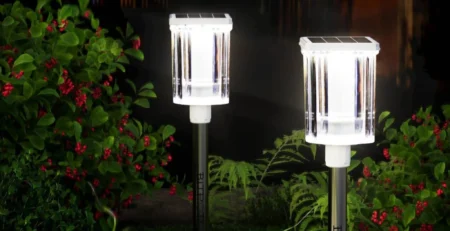
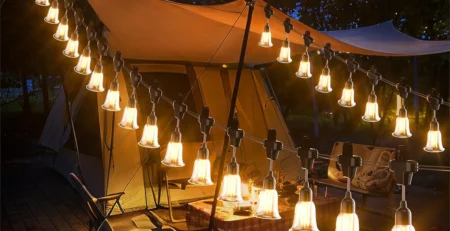
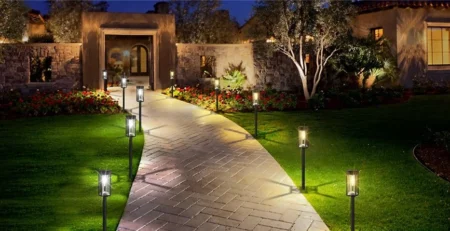
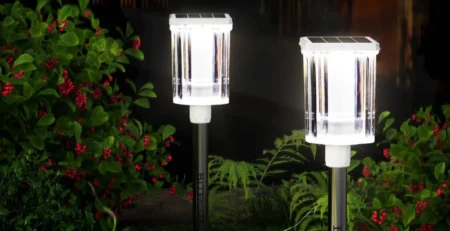
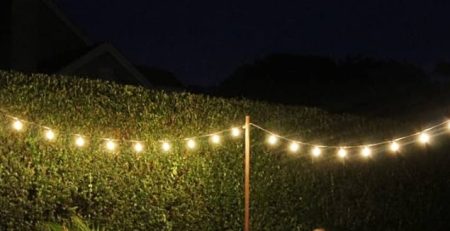

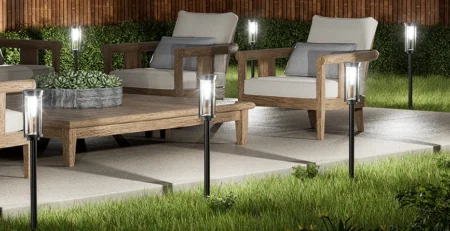


Leave a Reply